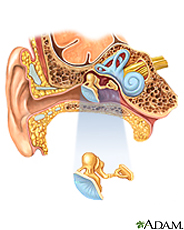 |
 |
 |
Other Health Topics:

-
Related Topics
-
Go Local
- Services and providers for Ear Disorders in the U.S.
-
National Institutes of Health
- The primary NIH organization for research on Ear Disorders is the National Institute on Deafness and Other Communication Disorders
Your ear has three main parts: outer, middle and inner. You use all of them in hearing. Sound waves come in through your outer ear. They reach your middle ear, where they make your eardrum vibrate. The vibrations are transmitted through three tiny bones, called ossicles, in your middle ear. The vibrations travel to your inner ear, a snail-shaped organ. The inner ear makes the nerve impulses that are sent to the brain. Your brain recognizes them as sounds. The inner ear also controls balance.
A variety of conditions may affect your hearing or balance. Ear infections are the most common illness in infants and young children. Tinnitus, a roaring in your ears, can be the result of loud noises, medicines or a variety of other causes. Meniere's disease may be the result of fluid problems in your inner ear; its symptoms include tinnitus and dizziness. Some ear disorders can result in hearing disorders and deafness.
- Ear Problems(American Academy of Family Physicians)
| Basics | Learn More | Multimedia & Cool Tools |
|---|---|---|
| Research | Reference Shelf | For You |
-
Latest News
- Guidelines Issued on Battling Ear Wax(08/29/2008, Reuters Health)
-
Diagnosis/Symptoms
- Ear Problems(American Academy of Family Physicians)
- Understanding Your Audiogram(American Academy of Audiology)
-
Treatment
- Ear Surgery: Otoplasty(American Society of Plastic Surgeons)
-
Specific Conditions
- Airplane Ear(Mayo Foundation for Medical Education and Research)
- Autoimmune Inner Ear Disease(American Academy of Otolaryngology--Head and Neck Surgery)
- Barotrauma(American Hearing Research Foundation)
- Cholesteatoma(American Academy of Otolaryngology--Head and Neck Surgery)
- Earwax(American Academy of Otolaryngology--Head and Neck Surgery)
- Foreign Object in the Ear(Mayo Foundation for Medical Education and Research)
-
Otosclerosis
 (National Institute on Deafness and Other Communication Disorders)
(National Institute on Deafness and Other Communication Disorders)
- Outer Ear Disorders: Injury(Merck & Co., Inc.)
- Outer Ear Disorders: Tumors(Merck & Co., Inc.)
- Perforated Eardrum(American Academy of Otolaryngology--Head and Neck Surgery)
- Perichondritis(Merck & Co., Inc.)
- Temporal Bone Fracture(Merck & Co., Inc.)
- Vestibular Neuronitis(Merck & Co., Inc.)
- Pictures & Photographs Return to top
-
Anatomy/Physiology
- Atlas of the Body: The Ear(American Medical Association)
- How the Ear Works(American Academy of Otolaryngology--Head and Neck Surgery)
-
Clinical Trials
-
ClinicalTrials.gov: Ear Diseases
 (National Institutes of Health)
(National Institutes of Health)
-
ClinicalTrials.gov: Ear Diseases
-
Journal Articles
References and abstracts from MEDLINE/PubMed (National Library of Medicine)
- Article: The Jahrsdoerfer grading scale in surgery to repair congenital aural...
- Article: Understanding auditory processing disorders.
- Article: Framework changes using costal cartilage for microtia reconstruction.
- Ear Disorders -- see more articles
- Ear cancers -- see more articles
- Ear wax -- see more articles
-
Dictionaries/Glossaries
-
NIDCD Glossary
 (National Institute on Deafness and Other Communication Disorders)
(National Institute on Deafness and Other Communication Disorders)
-
NIDCD Glossary
-
Directories
- Find an Otolaryngologist (ENT)(American Academy of Otolaryngology--Head and Neck Surgery)
-
Organizations
- American Academy of Otolaryngology--Head and Neck Surgery
-
National Institute on Deafness and Other Communication Disorders

-
Children
-
Enlarged Vestibular Aqueducts and Childhood Hearing Loss
 (National Institute on Deafness and Other Communication Disorders)
(National Institute on Deafness and Other Communication Disorders)
-
Flying and Your Child's Ears(Nemours Foundation)
Also available in Spanish
-
Taking Care of Your Ears(Nemours Foundation)
Also available in Spanish
- What's Cauliflower Ear?(Nemours Foundation)
-
What's Earwax?(Nemours Foundation)
Also available in Spanish
-
Your Ears(Nemours Foundation)
Also available in Spanish
-
Enlarged Vestibular Aqueducts and Childhood Hearing Loss
| Home | Health Topics | Drugs & Supplements | Encyclopedia | Dictionary | News | Directories | Other Resources | |
| Disclaimers | Copyright | Privacy | Accessibility | Quality Guidelines U.S. National Library of Medicine, 8600 Rockville Pike, Bethesda, MD 20894 National Institutes of Health | Department of Health & Human Services |
Date last updated: 16 September 2008 Topic last reviewed: 24 June 2008 |






